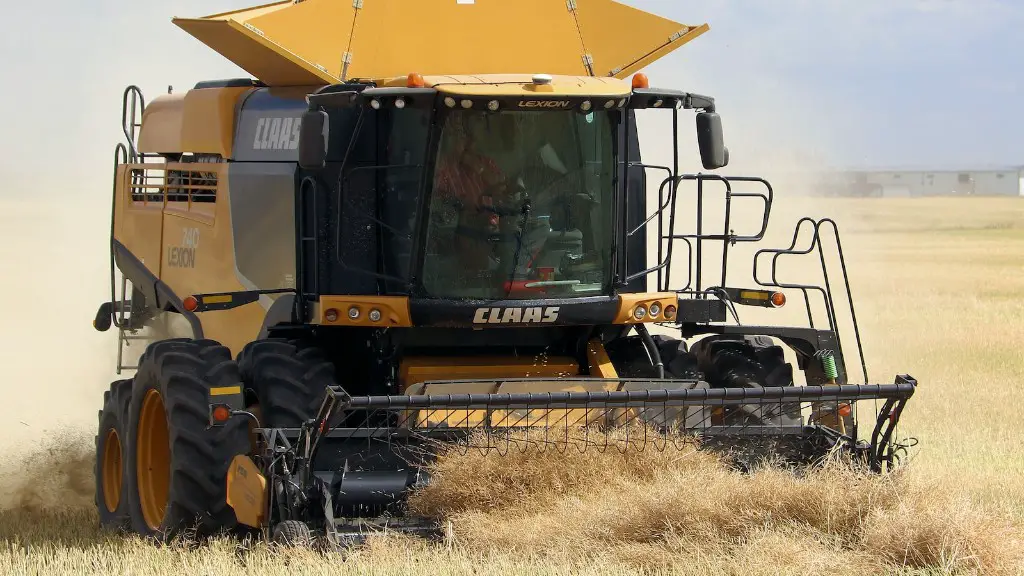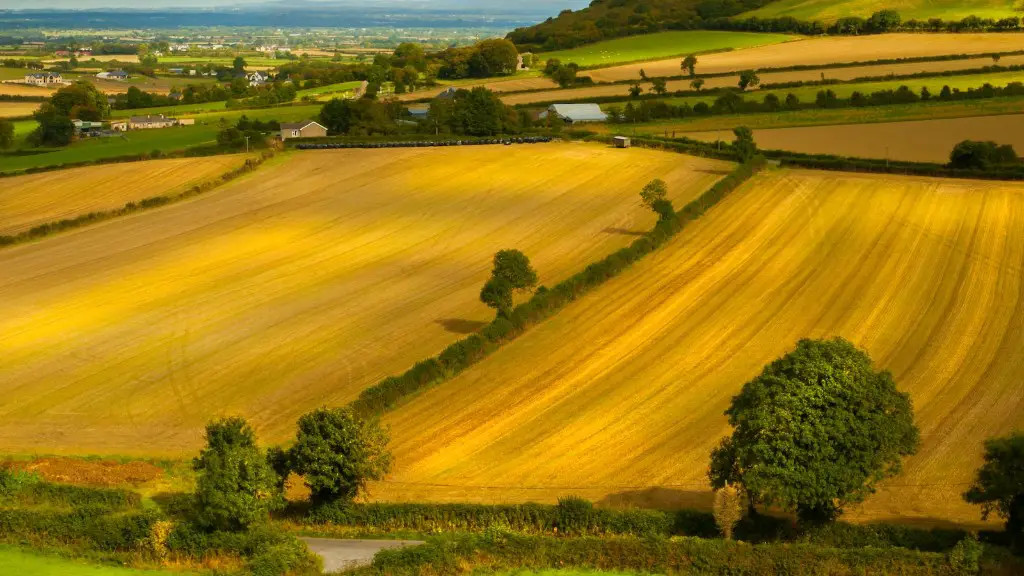Animal agriculture is a major contributor to global land use. It is estimated that around 45% of land available for human use is dedicated to animal agriculture, including crop production for animal feed and pasture for grazing. This land use includes about 30% of all the land on Earth, with the majority of it being dedicated to grass-fed livestock production. While it is true that animal agriculture contributes significantly to global food production, it has significant environmental impacts, such as increased water consumption, deforestation, and air and water pollution.
The majority of land dedicated to animal agriculture goes to pasture-based production, while the rest is used for animal feed production, such as growing crops, feeding hay and silage, and land dedicated to feed processing. Global production of animal feed is estimated to cover around 24% of total agricultural land. This feeds the meat and dairy animals, providing them with the necessary nutrition to grow and produce food.
Deforestation is a direct result of animal agriculture, as forests are cleared for pastures and, to a lesser extent, for animal feed production. Studies suggest that animal agriculture is responsible for up to 91% of deforestation in the Amazon rainforest, primarily for pasture and crop production for animal feed. Deforestation also has an effect on biodiversity, as it destroys habitats and reduces the amount of land available for wildlife.
In addition to the environmental impacts of animal agriculture, it has also been linked to major health issues, such as obesity and heart disease. In developed countries, around two-thirds of people are overweight or obese, largely due to diets high in animal products. Removing animal products from the diets of individuals, or reducing their consumption of these foods, has been linked to improved health outcomes. Further, high levels of meat and dairy consumption have been associated with increased risk of cardiovascular disease.
Animal agriculture has a large footprint on the Earth, with much of the land utilized being devoted to the production of food for animals. As the worldwide demand for animal products continues to rise, so too will the demand for land to produce these foods. It is important to be aware of the implications of animal agriculture, both in terms of its environmental impacts and its health risks, and consider alternatives, such as plant-based diets, in order to reduce the land devoted to animal agriculture.
Impact on food security
The use of land for animal agriculture can also impact food security, as it leads to a displacement of resources away from crop production and into animal-based production. As much as 20% of agricultural land is used for animal production, while only 2% of land is dedicated to producing plant-based proteins. This means that there is less land available to produce important food crops, leading to a decrease in food security in areas that rely heavily on animal agriculture.
The decreased availability of land for crop production due to animal agriculture means that there is less food available for people to eat, leading to food insecurity and malnutrition. This is particularly true in developing countries, where people rely heavily on animal-sourced foods that are more expensive and less nutrient-dense than plant-based foods. As a result, people often suffer from vitamin and mineral deficiencies that can lead to serious health problems.
The use of land for animal agriculture also affects the availability of water for crop production, as much of the resources are used for the production of animal feed. This means that there is less water available for irrigating crops, leading to decreased crop yields. In addition, the water used to grow animal feed is often contaminated with nitrates and phosphorus, which are pollutants that can impact water quality, leading to disruptions in water supply.
Overall, the use of land for animal agriculture can have a significant impact on food security and water availability, particularly in developing countries. By reducing the amount of land that is used for animal agriculture, we can free up resources that can be used to produce more food and improve access to clean water.
Impact on biodiversity
The use of land for animal agriculture can also have a significant impact on biodiversity and wildlife. Much of the land that is used for animal production is grassland, where native wildlife are often displaced in order to make way for the animals. This leads to a decrease in biodiversity, as the habitat for native wildlife is destroyed or reduced. Additionally, many of the animals that are raised for food are often non-native and can compete with native species for resources, leading to further loss of biodiversity.
The use of antibiotics and other chemicals, such as fertilizers, on pastures and crops used for animal feed can also have an impact on local biodiversity. These chemicals can accumulate in the soils, waterways, and air, leading to a decrease in biodiversity due to the presence of toxins and pollutants. Further, the use of fertilizers can lead to eutrophication, which is a process where oxygen levels decrease in water due to the presence of increased levels of nutrients.
The use of pesticides to control disease and pests in animal production can also have an adverse effect on local wildlife, as it can lead to the accumulation of toxins in the environment. Additionally, the overuse of pesticides can lead to the development of pesticide resistance, resulting in an increase in insect and disease outbreaks. This can lead to further loss of biodiversity, as the insects and diseases that are able to survive become more prominent in the environment.
Overall, the use of land for animal agriculture can have a significant impact on biodiversity and wildlife due to a variety of factors. To reduce the impact of animal agriculture on biodiversity, it is important to take steps to limit the use of pesticides and chemicals, manage animal populations, and protect and restore habitats.
Impact on water quality
The use of land for animal agriculture also has a significant impact on water quality. Many of the chemicals used in animal production, such as fertilizers, pesticides, and antibiotics, can accumulate in water sources, leading to water pollution. In addition, the livestock produce large amounts of waste, which can be a major source of water pollution if it is not properly managed. Runoff from animal feed can also be a source of water pollution, as it can contaminate waterways with nutrients and sediment.
The presence of these pollutants in water sources can lead to a decrease in water quality and a disruption in ecosystems. Polluted water can impact the health of fish and other aquatic organisms, leading to a decrease in biodiversity. Additionally, polluted water can make water sources unsafe for human consumption, leading to potential health risks.
The use of land for animal agriculture can also lead to water shortages. As much as 70% of fresh water is used for agriculture, with animal agriculture being a major user. This can result in water shortages in areas where there is already limited access to fresh water. Additionally, the presence of animal-produced pollutants in water sources can lead to further water shortages, as the polluted water is not suitable for human use.
Overall, the use of land for animal agriculture has a significant impact on water quality and availability, as it leads to water pollution and shortages. To reduce the impact of animal agriculture on water quality, it is important to take steps to limit the use of chemicals, manage animal waste, and restore natural habitats.
Impact on climate change
The use of land for animal agriculture can also have a significant impact on climate change. Animal agriculture is a major contributor to greenhouse gas emissions, with up to 18% of total emissions coming from the production of animal-sourced foods. Much of these emissions come from the production of animal feed, as it takes a large amount of energy to grow, harvest, and process the feed. Additionally, animal waste releases methane and nitrous oxide, both of which are potent greenhouse gases.
Deforestation to create pasture and croplands for animal feed is also a major contributor to climate change. Clearing forests releases large amounts of carbon dioxide, as well as reducing the amount of carbon stored in the vegetation. This can lead to an increase in global temperatures, as more carbon dioxide is released into the atmosphere.
The use of land for animal agriculture can also lead to water shortages, which can further contribute to climate change. As mentioned previously, the use of water for livestock can lead to water shortages in areas that are already facing water insecurity. This, in turn, can lead to an increased reliance on fossil fuels for energy generation. Additionally, the drying up of water sources can lead to the spread of deserts, which can amplify global warming.
Overall, the use of land for animal agriculture can have a significant impact on climate change. To reduce the effects of animal agriculture on the climate, it is important to reduce the consumption of animal-sourced foods, limit the use of chemicals, and restore natural habitats.





